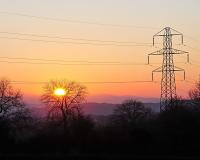
Vibrant Environment
Climate Change And Sustainability
All | Biodiversity | Climate Change and Sustainability | Environmental Justice | Governance and Rule of Law | Land Use and Natural Resources | Oceans and Coasts | Pollution Control

Would the formation of a regional power market in the western United States be a step forward into a more sustainable future or a stumble backward into continued use of fossil fuels for the region? Much of the debate concerns how a regional power market would increase or reduce greenhouse gas (GHG) emissions. Advocates of the regional power market argue that with increased use of renewable energy and its more efficient integration and transfer, carbon emissions would decrease. In contrast, proponents against the new framework maintain that less state control over their energy grids could result in less support for renewable energy and an increased use of coal. The formation of this market could lead to a cleaner, greener future or it could incentivize continued use of fossil fuels within some of the western states.

Does “meat” have to come from a living, breathing animal? According to proponents of cellular agriculture, this may not always be the case. This new industry aims to produce “meat” by growing animal cells outside of a living body, envisioning a future where humans can consume beef, pork, chicken, and seafood without having to slaughter a single animal. The process of producing such cell-based food involves taking cells from a live animal and using a growth medium to grow the cells into large, edible tissue. In recent years, this technology has generated public excitement, attention, and, most importantly, investment. However, regardless of what the products of cellular agriculture look like or when this technology will be fully developed, naming this product is much more complicated.

Over the last several decades, many countries have sought to decrease their carbon footprint by creating stricter emissions standards for motor vehicles. However, once these standards are in place, a serious question arises: what should be done with older, “dirtier” vehicles? Often, the answer has been to export them to regions with less strict vehicle standards.

Carbon capture and storage (CCS) is a hot-button topic as a strategy to mitigate climate change and reduce greenhouse gas emissions. CCS entails capturing carbon dioxide from the atmosphere and industrial plants at the source, then injecting the captured carbon dioxide into underground geologic formations for storage. Much research has focused on sequestering carbon dioxide onshore, in depleted oil and gas reservoirs or deep saline aquifers. Offshore CCS also may be feasible, but presents several governance and legal challenges.

Climate change threatens to dramatically increase inequality and create greater hardships for women and girls, in large part because of their disproportionately vulnerable economic, social, and political positions worldwide. Food shortages disproportionately affect the health of women and girls, and in many regions, women are more directly dependent on natural resources threatened by climate change for their livelihoods. For instance, a U.N. report observed that in developing countries, women account for 45-80% of all food production, and about two-thirds of the female labor force is engaged in agricultural work. In such developing regions, women face unique vulnerabilities from the increasing unpredictability of food sources as well as the loss of income or jobs if agricultural resources are impacted by climate change.

When’s the last time you found yourself idly shopping out of boredom or buying a shirt just because it was on sale? If it was in the last week, then you’re not alone. The average American shopper buys 60% more clothing today than they did just 15 years ago, but keeps it for only half as long. At the end of the year, this results in approximately 80 pounds of unwanted clothing per person!

With the help of the U.S. Congress, the U.S. Department of the Interior (DOI) has had a long and proud history of tackling pressing challenges through responsible and inclusive management of America’s public lands. One might expect it would continue that tradition as climate change has become a major challenge confronting the nation.

With climate change actively intensifying impacts from natural disasters, it is now more important than ever to design and implement community resilience plans and actions that will minimize damage when disasters occur. To prepare for an increasingly uncertain and fraught future, communities are identifying vulnerabilities, planning for forthcoming disasters, and taking action to become more resilient. But what exactly does resilience mean? What does it mean to be a resilient community? And, importantly, is there a concrete way to measure a community’s progress toward resilience as it is defined by the community so that its members can ensure they are taking appropriate steps to be better able to respond to a new normal?

Women have been leaders in every major movement, though their contributions all too often go unrecognized. The environmental movement is no exception. Women striving toward the betterment of this field have faced many challenges, but through skill and determination, they persevered. The environmental movement is over two centuries long with generations of women shaping policies and laws within the field. This blog features just a handful of the numerous women who paved the way for future environmentally conscious generations.

Many have argued that gender equality and women’s empowerment are essential to advancement in many areas of life, such as business, health, and education. This brief blog post posits that the field of sustainable development and environmental protection are no different. Gender equality and, more particularly, women’s empowerment, are critical to achieving sustainable development across the globe. It is not a one-size-fits-all proposition, and the gender differences and deeply rooted policies that perpetuate inequality differ from region to region.